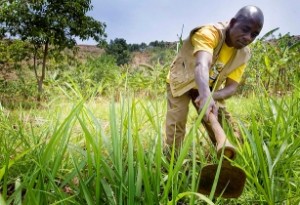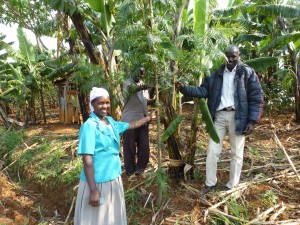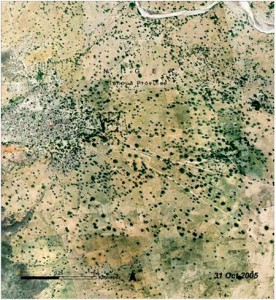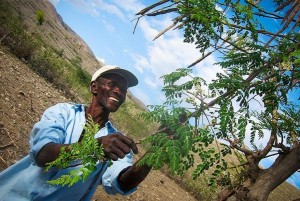 A large-scale project that seeks to help smallholders adapt to climate change by practicing agricultural systems that integrate tree planting, rearing of livestock and crop production has begun in West Africa. the Building Resilient Agro-forestry Pastoral Systems through Participatory Action Research (BRAS-PAR) project aims to improve the understanding of farmers’ perceptions and demands by addressing barriers to technology adoption while taking into consideration gender and social differentiation.
A large-scale project that seeks to help smallholders adapt to climate change by practicing agricultural systems that integrate tree planting, rearing of livestock and crop production has begun in West Africa. the Building Resilient Agro-forestry Pastoral Systems through Participatory Action Research (BRAS-PAR) project aims to improve the understanding of farmers’ perceptions and demands by addressing barriers to technology adoption while taking into consideration gender and social differentiation.
Category Archives: News
 Integrating trees, crops and livestock into farming systems translates to drought resilient, productive and sustainable systems. This innovation has drawn the attention of farmers, cultivating new trees in their farms for the purpose of providing fodder, fuel, food as well as other domestic needs. With ample training on these technologies and support from relevant institutions, farmers’ dependency on rangelands and frustrations on low productivity levels reduces as experienced in diverse African nations.
Integrating trees, crops and livestock into farming systems translates to drought resilient, productive and sustainable systems. This innovation has drawn the attention of farmers, cultivating new trees in their farms for the purpose of providing fodder, fuel, food as well as other domestic needs. With ample training on these technologies and support from relevant institutions, farmers’ dependency on rangelands and frustrations on low productivity levels reduces as experienced in diverse African nations.

The International Forestry Review has recently published a collection of papers on gender in Agroforestry. These papers provide insight into the roles, benefits and perceptions of both men and women in Agroforestry. We consider some of these insights and emerging lessons for Evergreen Agriculture.
The full issue includes studies from Asia, Africa and South America and highlights the great diversity in the roles men and women play in agroforestry between regions, countries and ethnic groups. Gendered roles and responsibilities impact who can plant what variety of tree and where, who cares for these trees and who benefits from which specific parts of the tree. For example women in Africa generally have rights over indigenous fruits such as shea, while men almost universally own tree commodities such as timber.
These varying gender roles and responsibilities can influence both the practice of Agroforestry and dictate who benefits from it. For this reason, gender should be considered in Evergreen Agriculture activities. Some lessons for Evergreen Agriculture from these recent studies include:
 • It is important to understand the roles and responsibilities men and women have in terms of tree planting, management and harvesting in project areas.
• It is important to understand the roles and responsibilities men and women have in terms of tree planting, management and harvesting in project areas.
Men and women are likely to prefer different tree species based on the control they have over the products coming from the species. Targeting training and provision of species on to men and women based on their priorities is likely to increase adoption.
• When providing training consider the accessibility and appropriateness of the materials for both men and women.
There are many more gender lessons for Evergreen Agriculture in the full issue and other readily available resources. By considering gender in your activities you could greatly improve tree planting and a more equitable sharing of the benefits.
“Evergreen Agriculture systems replenish soil fertility, provide food, fodder, timber and fuelwood, translating to greater value than that of the annual crop within the area that they occupy,” notes Dennis Garrity. The inclusion of trees in cultivated landscapes results in an average value of $1.40/year and increased dietary diversity among children in African countries.
 Following the release of their significant report “Scaling Up Regreening: Six Steps to Success, A Practical Approach to Forest and Landscape Restoration” Chris Reij and Robert Winterbottom, of WRI and founding members of the EverGreen Agriculture Partnership, have called upon investors in the development sector, such as the Gates Foundation, to give more consideration to the proven potential of regreening to support food security and rural development in many parts of the world.
Following the release of their significant report “Scaling Up Regreening: Six Steps to Success, A Practical Approach to Forest and Landscape Restoration” Chris Reij and Robert Winterbottom, of WRI and founding members of the EverGreen Agriculture Partnership, have called upon investors in the development sector, such as the Gates Foundation, to give more consideration to the proven potential of regreening to support food security and rural development in many parts of the world.
In a recent interview with David Brown, published by the Mongabay Reporting Network, Reij and Winterbottom explain the potential of regreening further, and what is needed to scale it up. Read here for the full story.
Numerous studies have supported the link between deforestation and poverty in the country. One hundred thousand children under the age of five suffer from acute malnutrition, less than half of households have access to safe water, and one-third of the women and children are anemic. Everyone from conservationists to actor Sean Penn sees trees as the answer. The question is, which trees?
Some believe the answer could be moringa, a native of the Himalayan foothills in northwestern India and the latest imported ingredient anointed with “It Superfood” status (see also: quinoa, acai, chia). The tree—called variously “the miracle tree,” “tree of life,” “mother’s best friend,” and the “never die tree”—can shoot from seed to 15-foot stature in the span of a year; flourishes in hot, dry subtropical climates; and can be put to use from root to pod. Nutritionally, moringa has more calcium than milk, more vitamin C than oranges, more vitamin A than carrots, more iron than spinach, more potassium than bananas, and just as much protein as eggs.



